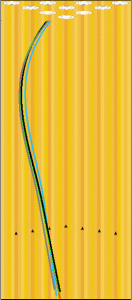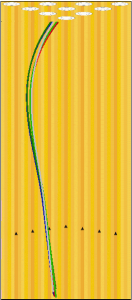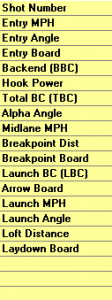See written review and video at Hammer Midnight Vibe Ball Review
Here is a supplemental review with Digitrax Analysis.
Below, you can see all tracks and the average track as recorded by Ebonite Digitrax. On the left, you can see the statistical analysis.
I am bowling on a medium to medium-light house shot with dry boards outside 5. It’s a pretty steep cliff from wet to dry around the 7 board so I try to target inside the 2nd or 3rd breakzone to stay away from the dry. I have 350-400 revs on any given shot and I average between 220 and 230 in this house.
Let’s evaluate…
I performed tracking on this ball using 2 different breakzones so that you can see how it reacts. The left tracking snapshot matches up to the left statistics. You will notice that I launch the ball at about 16 mph in both types of shots, but the laydown board is slightly different allowing me to square up or open up, depending on what breakpoint I intend to hit. Very small differences in launch angle account for a 3 board difference at the breakpoint. For both shot types, I use the exact same target at the arrows.The first shot, I target around 7 at the breakpoint whereas in the second, I target around 10. Right away, you will notice the major difference is the entry angle. Getting this ball out to the dry boards will generate higher entry angles. However, a benefit of this ball is that it is still capable of over 5 degrees of entry angle from deeper inside.
This core is of moderate strength so you expect it to play a part in the overall ball reaction. I find that this core has matched up pretty well for house shots for almost everybody who has ever thrown it. In contrast to an smooth reacting, early revving core, this core is capable of pushing longer, but then flips and rolls out. Its cylindrical shape provides that reaction. You can see more of an explanation in the full ball review. The main thing with this ball is that in the out of box finish, it is very clean through the fronts. I wouldn’t want to use it on medium-heavy conditions. I find it to have a bit of a skid snap type of reaction, particularly when sent to the outside. However, it hass a much smoother transition when thrown a little further inside at the breakpoint. I find that it’s a ball that carries pretty well from the outside because of the reaction shape and roll out. It generates slightly lower entry angles than some of the big skid snap balls, which I think helps. See my article on entry angle for more detail. I can see a lot of people liking this ball for a house shot. One of my favorite balls of all time is a Cherry Vibe. It has the same core, but the reaction is a bit different. They have a family resemblance, but the Cherry is quite a bit stronger from my own experience. It is also better on the fresh shot. The Midnight Vibe reacts more consistently a broken down shot. But when it cam be used, it can be used for a while.
Bottom Line
The Midnight Vibe is a ball that is very clean through the fronts and has compact hook and roll reaction. That means it will be fully in the roll phase when hitting the pocket. That tends to provide ideal carry. I find this to be a great ball when the lanes have broken down and your tired of trying to force your more aggressive equipment down the lane. It makes a consistent and moderately strong move on the backend. Don’t mistake this for a weak ball. It is a little stronger than you might want for a “weaker” ball in your arsenal, but depending on your style, it can fill the weaker end quite well. It provides a pretty different reaction than the Backlashes and thus properly fits above them in strength.







Coach T:
“Oh! Now I get it!”
Many thanks for your personal explanation of using Digitrax. It’s a great addition and eye-opener. Once again, your site has given me another “Eureka!” moment. I’ve seen the diagrams before, but until now I haven’t understood how to interpret some of the stats.
What triggered my insight was noting the increase of ball speed between the initial launch and midlane. At first, this made no sense, because a launched ball has a finite amount of energy generated by the swing, and this energy has to decrease as the ball progresses. So this forward speed energy must be coming from spin energy, getting converted. After that realization, RG/Diff/Flare stats started making a lot more sense.
Now I’m wondering if Digitrax needs to know how much the ball weighs in ordering to do its calculations?
RM, 02/04/11
Hi. I’m glad I can continue to post stuff that helps.
I just want to clarify something in your comments. The ball does slow down from launch to midlane to entry. You’ll see that the mph at each of those is progressively less as it goes down the lane. It will decelerate faster if there is more friction. However, the ball will increase revolutions as it goes down the lane due to that friction and transitioning from skid to hook to roll. I think those are the things that can help you understand RG, etc. The lower the RG, the quicker the ball will want to transition to roll and thus will appear to roll faster because of the obvious end-over-end roll.
I hope that helps.
Coach T —
Yes, the ball has finite energy, which dissipates due to friction. So, if rolled down an endless lane, a ball will eventually come to a stop. What I didn’t realize is that the conversion of spin-energy would allow the ball to go faster, though for a brief time and distance, despite having less overall energy. I find the implications of this fascinating, perhaps because I’ve never had a physics course.
‘nough said for now.